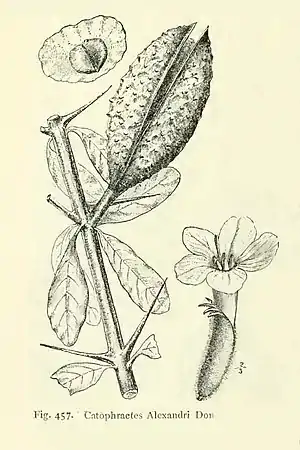| Catophractes | |
|---|---|
 | |
| Scientific classification | |
| Kingdom: | Plantae |
| Clade: | Tracheophytes |
| Clade: | Angiosperms |
| Clade: | Eudicots |
| Clade: | Asterids |
| Order: | Lamiales |
| Family: | Bignoniaceae |
| Clade: | Crescentiina |
| Clade: | Paleotropical clade |
| Genus: | Catophractes D.Don |
| Species: | C. alexandri |
| Binomial name | |
| Catophractes alexandri | |
 | |
| Catophractes alexandri distribution | |
| Synonyms[1] | |
| |
Catophractes alexandri, the only species in the genus Catophractes, is a spiny shrub or small tree up to 3m tall, belonging to the family Bignoniaceae and occurring in the hot, low-rainfall regions of Namibia, the Northern Cape, Kalahari Desert, Botswana, western Zimbabwe and Limpopo. Preferring calcrete, limestone outcrops and soils, the species often forms pure communities, or grows in association with Colophospermum mopane, Rhigozum virgatum, Phaeoptilum spinosum and Acacia nebrownii. It is parasitised by several Tapinanthus spp.[2]
The specific name honours James Edward Alexander, the Victorian soldier and explorer, while the generic name refers to leaves and flowers arising from below the paired, decussate, opposite spines. Leaves are tufted (fascicled) or opposite, and densely tomentose and grey. They are simple and elliptic to obovate, up to 4 cm long, and with coarsely dentate or scalloped margins. The white or pink flowers, produced after rain, are about 10 cm in length, fragrant, showy or specious, 5-lobed, and with a yellow throat. Inside the tube there is a broad, villous band below the origin of the filaments. The calyx is tubular with linear teeth, and slit on one side. The fruit is a flattened, woody capsule, some 10 cm long, warty and splitting or dehiscing across the flat faces into two equal parts. Old fruits are pendant and produce a characteristic clicking sound in light breezes, caused by the castanet-like tapping of the two hollow parts. Seeds are papery and winged.[3]
Descriptions of this species appeared in "Ann. Nat. Hist." ii. (1839) 375;—"Proc. Linn. Soc." i. (1839) 4; "Trans. Linn. Soc." xviii. (1841) 307, t. 22; "DC. Prodr." ix. 233; Kuntze in "Jahrb. Bot. Gart. Berl." iv. (1886) 270; Engl. in "Engl. Jahrb." x. 255; K. Schum. in "Engl. & Prantl, Pflanzenf." iv. 3B, 233.
Medicinal use
The root is chewed for stomach complaints, and when added to the root of Polygala leptophylla Burch., is used as a decoction for abdominal pain, especially in children. Leaf, root and bark infusions and decoctions are used to treat colds and coughs.[4]
Local names
- !khabab - Damara
- Omukaravize - Otjiherero
- Gabbabos - Afrikaans[5]
Synonyms
- Catophractes welwitschi Seem., in Journ. Bot. 1865, 331, t. 39.
- Catophractes kolbeana Harv., Gen. S. Afr. Pl. ed. ii. 276.
References
- ↑ "Catophractes alexandri D.Don". World Checklist of Selected Plant Families. Royal Botanic Gardens, Kew. Retrieved 30 March 2014 – via The Plant List. Note that this website has been superseded by World Flora Online
- ↑ "Archived copy" (PDF). Archived from the original (PDF) on 2014-03-26. Retrieved 2014-03-26.
{{cite web}}: CS1 maint: archived copy as title (link) - ↑ "Wild Flowers of the Limpopo Valley" - vd Walt, Retief, Marais (2009)
- ↑ "People's Plants" - Ben-Erik van Wyk, Nigel Gericke (Briza, 2000)
- ↑ "Trumpet-thorn, Catophractes alexandri in Namibia". Archived from the original on 2014-03-28. Retrieved 2014-03-28.
External links
Gallery
 From "Journal of Botany, British and Foreign" (1865)
From "Journal of Botany, British and Foreign" (1865) From "Die Pflanzenwelt Afrikas" (1910)
From "Die Pflanzenwelt Afrikas" (1910) Southern Zimbabwe
Southern Zimbabwe